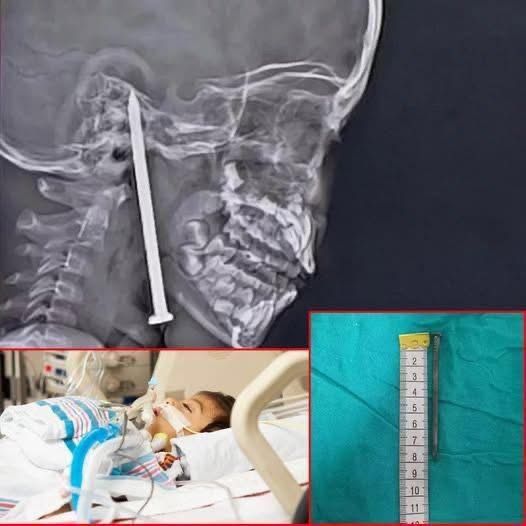A 7-year-old boy miraculously survived a horrifying playground accident after a three-inch nail pierced through his neck and into his brain—a case that doctors are calling nothing short of extraordinary. What began as a regular day quickly turned into a life-or-death situation, sending shockwaves through the small community of Balrampur and capturing national attention.
The child was immediately rushed to King George’s Medical University (KGMU), where a series of emergency scans revealed the true extent of the injury. The nail had entered through the lower part of his neck and jaw, continuing upward into his skull. MRI imaging showed just how dangerously close the sharp object came to a vital blood vessel—mere millimeters away from causing instant death or irreversible brain damage.
Doctors acted swiftly, assembling a highly specialized surgical team from both the Neurosurgery and ENT departments. The medical staff knew they were dealing with a high-risk, high-stakes operation where even the slightest misstep could prove fatal. Dr. Sandip Tiwari, one of the lead surgeons, explained that during their investigation, they confirmed the nail had traveled from the base of the neck and lodged itself into the brain, narrowly avoiding catastrophe.
The surgery took four hours and required unparalleled precision. The team worked delicately to remove the 2.27-inch nail while navigating through a densely packed region of nerves and blood vessels between the boy’s mouth and brainstem. According to Professor Samir Misra from the Trauma Surgery Department, the procedure demanded flawless coordination and expertise—any wrong move could have left the boy permanently disabled or worse.
Following the operation, the child was transferred to the Pediatric Intensive Care Unit for close monitoring. Despite the severity of the trauma, his condition was declared stable. Doctors remain cautiously optimistic, noting that although the surgery was a success, he will need to be observed over time for any neurological or developmental issues that could emerge later.
The hospital’s medical superintendent confirmed that this case will soon be documented and submitted to an international medical journal due to its rarity and complexity. They hope the detailed report will serve as a valuable reference for doctors across the globe who may encounter similarly severe trauma cases in children.
The boy’s family has chosen to stay away from public attention, but local sources say they are overwhelmed with gratitude for the medical team’s swift action and skill. Community members have praised the hospital’s efforts, calling it a miracle of modern medicine and a testament to the capabilities of India’s healthcare system.
This extraordinary survival story shines a powerful light on the importance of rapid trauma response, especially in pediatric cases. It also showcases the life-saving potential of collaborative, interdisciplinary medical teams trained to handle the most delicate emergencies. The boy’s recovery journey has just begun, but the fact that he’s alive at all is nothing short of a miracle—one that will not be forgotten anytime soon.
